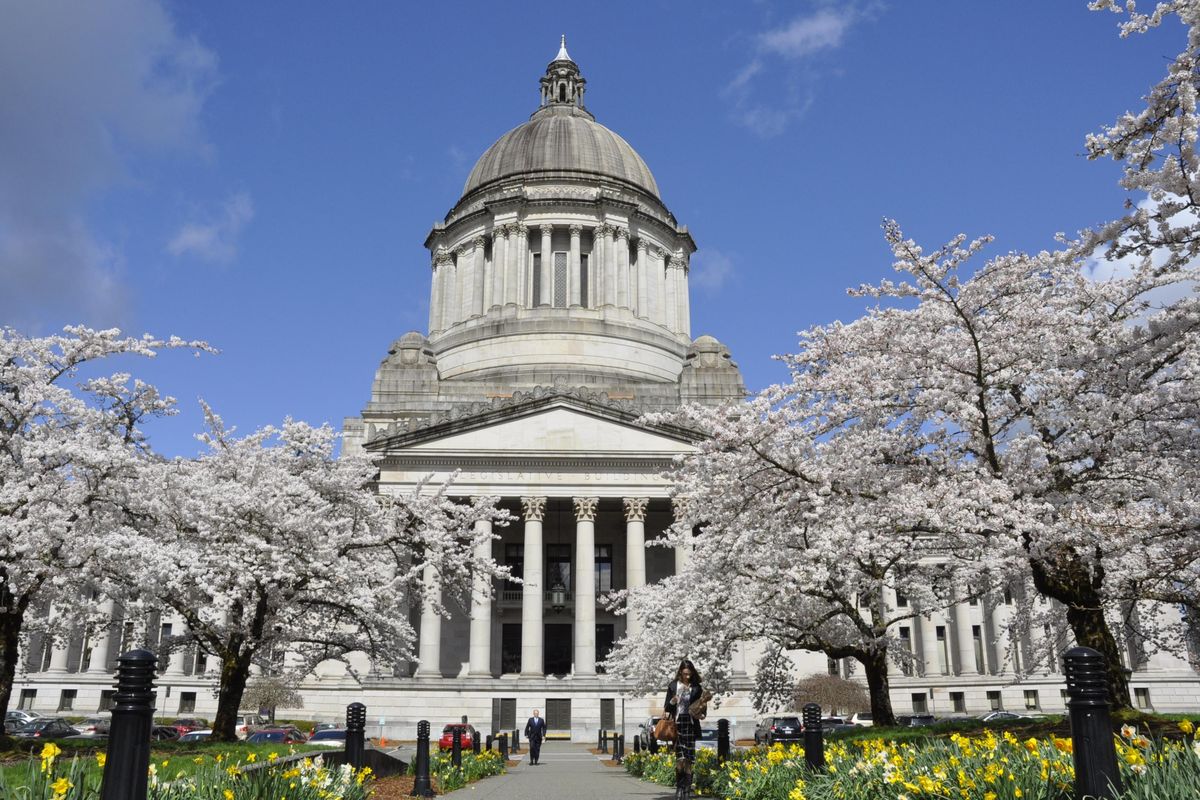Cherry blossom time at state capital brightens spring days

OLYMPIA – Whether March goes out like a lion or a lamb in the state capital, it almost always blends into April with the most attractive time of the year, cherry blossom season. 2017 is no exception.
Flowering cherry trees between the domed Legislative Building and the House and Senate office buildings burst open with white flowers in late March, providing some bright color to the otherwise drab weeks marked by rain outdoors and long budget hearings indoors.
They form a favorite backdrop for tourists visiting the grounds, and even jaded journalists and longtime lobbyists pause on trips between committee rooms to snap selfies. When the blossoms dry in the coming days, any slight breeze will create a blizzard-like shower of petals.
The Capitol Campus has more than 100 varieties of trees, according to a tourist brochure. Some even predate the buildings, including some maples that were left on the grounds during the construction in the 1920s by the Olmsted Brothers company, landscape architects hired to shape the new campus. The maples are now so big that their massive limbs are supported by steel braces.
The only tree watched more closely than the flowering cherries is the large Saucer Magnolia at the southeast entrance to the Legislative Building. It’s called the “Sine Die Tree” because the session is supposed to end either when the blossoms are in full bloom, or when they fall off – legends vary. Because of special sessions, that hasn’t actually happened for years, so it’s possible the magnolia needs a new name.
As popular as the cherry trees are now, they were not part of the original plans for the Capitol grounds drawn up by Olmsted Brothers, who also developed a park plan for Spokane as well as designing New York’s Central Park.
State Horticulturalist Brent Chapman said the Olmsteds planned other flowering trees like dogwoods, which are better adapted to the Puget Sound climate, for the campus.
When Japan donated some flowering cherries to the nation’s capital in the 1920s, however, the ornamental trees became so popular that many state capitals followed that lead.
In 1932, pink-blossomed Kwansan cherry trees were planted along what is now Cherry Lane, a short street running along the east side of the Legislative Building for a couple of blocks before ending at the north end of the Temple of Justice.
To mark the nation’s bicentennial in 1976, a grove of white-blossomed Yoshino trees were planted on the northeast corner of the main campus. In keeping with the Spirit of ’76, 13 trees were planted, but disease and bad weather has taken out six of them.
They are in full bloom now, as are a phalanx of Yoshinos that fill the lawns across from the south entrance to the Legislative Building. A gift from a Japanese newspaper publisher in the city of Yoshino in 1984, they are younger than some of the Kwansans but significantly larger, thriving on sloping grounds with good drainage. The groundskeepers must trim them occasionally to keep their branches from scraping against the House and Senate office buildings, Chapman said.
“We don’t do a lot of pruning,” Chapman said, and the shallow root systems rarely cause problems for the nearby buildings’ plumbing or sewage.
The Kwansans, which will blossom in a week or two, were planted in an area with poor drainage that is not a good location for that species, Chapman said. They are also susceptible to bugs and disease, and have a lifespan of only about 30 years. They’ve been replaced several times, and most are now nearing the end of their life cycle.
“They’re not really happy here,” Chapman said.
That has state officials who oversee the Capitol grounds and its master plan wondering whether the Kwansans should be replaced with another kind of tree that’s native to the Northwest. They could go with conifers, or the Olmsteds’ preferred choice, dogwoods. That might mean that in the near future there would be no cherry trees along Cherry Lane.
“That would be odd, wouldn’t it?” Chapman agreed, although the same committee that will decide whether to plant a different kind of tree there could also change the name of the street.